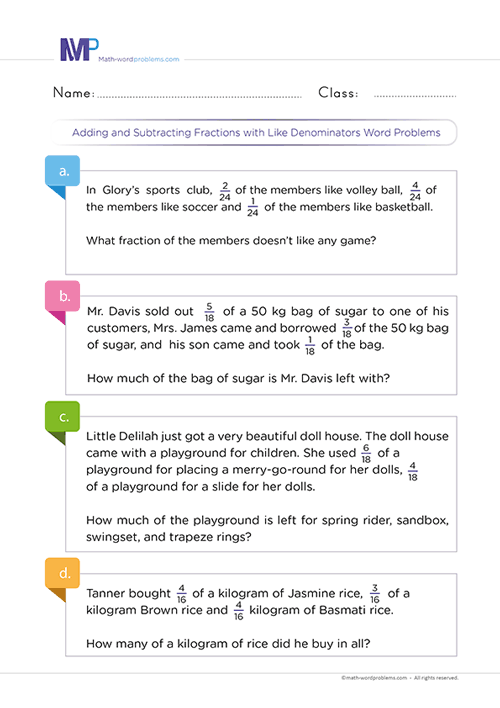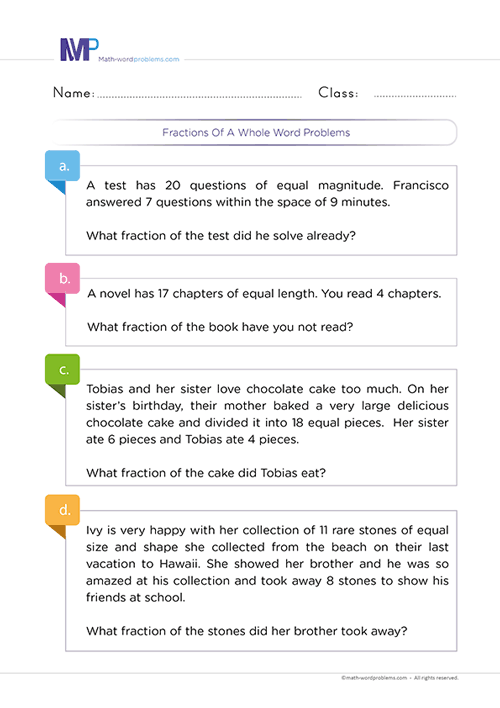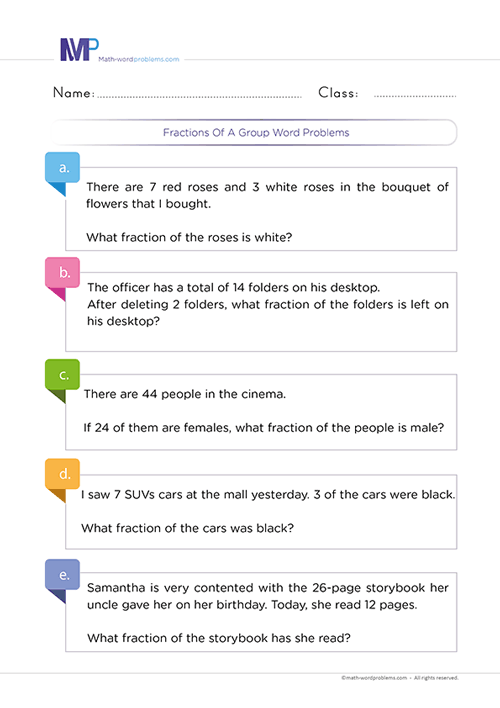 What is the best strategy to add and subtract fractions with like denominators word problems?
What is the best strategy to add and subtract fractions with like denominators word problems?

- INTRODUCTION
- Step 1 IDENTIFY
- Step 2 STRATEGIZE
- Step 3 SET UP
- Step 4 PROVIDE A SOLUTION
- Step 5 CHECK YOUR WORK
Get more contents on this skill...
What is the best strategy to add and subtract fractions with like denominators word problems? Our unique and well-organized step-by-step guide below offers 3rd Graders all the skills they need to add and subtract fractions with like denominators word problems successfully. In fact, this guide will reduce the common mistakes that 3rd grades often make when solving addition and subtraction of fractions with like denominators such as:
- Systematic errors
- Negligence errors
- Lack of understanding of the process involved in solving fractions,
- Adding or subtracting the denominators in add-and-subtract fractions
- Difficulty in converting to the same denominator before performing addition or subtraction operations,
- Difficulty in working with mixed numbers.
However, apart from eliminating these common mistakes, let's find out what is the best strategy to add and subtract fractions with like denominators word problems that will enhance kids' math reasoning and problem-solving in fractions and other math operations, thus connecting their fraction skills to algebraic concepts in advanced mathematics.
Steps adding and subtracting fractions with like denominators word problems
These outstanding steps on adding and subtracting fractions with like denominators word problems will significantly enhance kids' procedural understanding, i.e., their ability to read and understand a problem, identify the problem type, set up an equation, then solve it accurately.
Understanding the best strategy to add and subtract fractions with like denominators word problems is a vital building block for advancing in elementary mathematics. For this reason, this remarkable guide will outline the necessary techniques for understanding all the concepts and tricks in adding and subtracting fractions with like denominator word problems.
To successfully achieve this, the following challenging yet fun real-life examples are designed to show kids how fantastic these steps work.
Step 1 IDENTIFY THE PROBLEM
To identify the problem,
- Start by reading out the problem carefully to understand its description.
- Then, identify and underline related statements.
- Now, reread the problem and figure out vital information like important fractions and keywords.
- Next, use the following keywords as the first guide to identify whether the problem involves the addition or subtraction of fractions.
The keywords that you’ll likely see when you encounter addition of fractions with like denominators word problems are: add, plus, more, total, in total, increase, together/all together, altogether combined, sum, grow, join, both, in all, and, how many in all, how much, etc.
On the other hand, If it is the subtraction of fractions with like denominators word problems, then you will see at least one of the keywords below in the word problem: less, less than, excluding, minus, take away, left, decrease, difference, fewer, deduct, remain, change, how many more, leftover, less than, how much longer/shorter, fewer than, discount, etc.
Note: learners should understand that it would be best not to rely entirely on keywords alone because a particular keyword can have different meanings in different word problems.
In that case, you need to read the question very well to understand the situation the word problem describes. After reading, you will also find out if the problem makes sense first before determining which operation you need to use.
Step 2 STRATEGIZE AND DETERMINE THE OPERATIONS
As you move on to this step, ask yourself this pertinent question because it helps, “how will I handle this problem?”
Here, you will apply the read-to-understand rule. i.e., you have to read the word problem and try to interpret it in your own words.
Since each word problem may require a different solving format, the key points below will enable you to tackle any word problem irrespective of the format.
- First, in most cases, the keyword(s) in the word problem will help clarify the operation you need to carry out.
- Then, another critical thing to remember is, for addition and subtraction of fractions, all fractions must have the same denominators. Since you are already dealing with fractions with like denominators, you are good to go.
- But, relying on keywords alone to solve word problems has some limits, as mentioned in step 1 above.
- Hence, you must first read the word problem to understand the situation that the problem is describing.
- Reading the problem to understand will lead you to be able to identify the problem type and relative statements in the word problem, which, together with the keyword(s) in the problem, will determine the correct maths operation that you need to use
Step 3 SET UP A NUMBER SENTENCE AND AN EQUATION
- Now, after knowing which operation you will perform from step 2 above, construct short sentences to represent the information given in the word problem.
- These short sentences represent the vital information that makes it easier to solve the word problem. In order words, it is like a diagram of the word problem.
- Then, you can deduce a solvable maths equation to represent the information given in the phrases you constructed above.
Step 4 SOLVE THE PROBLEM
From Step 3 above,
- Add or subtract the fractions by adding or subtracting the numerators together while leaving the denominator the same.
- Furthermore, simplify the fraction if possible.
- Also, remember to include the unit of measurement in the final answer.
Step 5 VERIFY YOUR ANSWER
Finally, check your work to make sure that your answer is correct. For instance, since you are dealing with only numbers and not algebraic expressions, it is good to use reasonableness by estimation to see if your answer makes sense.
Therefore, if you estimate and the answer is close to what you have, your answer is correct. However, if your answer is beyond reasonable limits, you must go back to step one and start again.
Examples of how to solve fractions of a number word problems
Example one: solution a
- How many a kilogram of rice did he buy in all?
- How many more kilograms of Jasmine rice did he buy than Brown rice?
- How many more kilograms of Brown rice and Basmati rice than Jasmine rice did he buy?
Step 1:Read the problem and underline all the relational statements. The important fractions here are
Step 2:So, the question is, how will you solve this problem?
Here, you need to reread the problem and interpret it in your own words without numbers or fractions to come out with the correct operation without necessarily depending on the keyword.
The problem is telling you that Jack bought a certain fraction of Jasmine, Brown, and Basmati rice, respectively.
Now, the problem wants you to calculate the kilograms of rice he bought.
Therefore, “which operation can join two similar things/fractions into one?
So you see, from the situation that the problem is describing, from interpreting the problem in your own words and the keyword found in the word problem calls for an addition of fractions operation.
Step 3: Next, construct short sentences representing the most vital information in the word problem.
Now, you need to translate the sentence that is in bold below into an accurate solvable math equation.
- Quantity of Jasmine rice he bought =
of a kilogram - Quantity of Brown rice he bought =
of a kilogram - Quantity of Basmati rice he bought =
of a kilogram - Therefore, the total kilogram of rice he bought = the quantity of Jasmine rice he bought + the quantity of Brown rice he bought + the quantity of Basmati rice he bought.
Step 4: From Step 3 above,
- Add the fractions by adding the numerators together while leaving the denominator the same.
- Furthermore, simplify the fraction if possible.
- Also, remember to include the unit of measurement in the final answer.
So, he bought 2 kilograms of rice in all.
Step 5: Finally, check your work to ensure your answer is correct. Since you are dealing with only numbers and not algebraic expressions, it is good to use reasonableness by estimation to see if your answer makes sense.
So, if you estimate and the answer is close to the one you have, then your answer is correct. However, if your answer is beyond reasonable limits, you must go back to step one and start again.
Example one: solution b
Step 1:Read the problem and underline all the relational statements. The important fractions here are
Step 2:Next, ask yourself, “how will you solve this problem? ”
Here, you need to reread the problem and interpret it in your own words without numbers or fractions to come out with the correct operation without necessarily depending on the keyword.
The problem is telling you that Jack bought a certain fraction of Jasmine, Brown, and Basmati rice, respectively.
Now, the problem wants you to calculate how many more kilograms of Jasmine rice than brown rice did he buy.
Therefore, you should ask yourself: “which operation can I use to find out what is left of something and compare if it is more or less to the other?”
So you see that, from the situation that the problem is describing, from retelling the problem in your own words, and from the keyword found in the word problem, you must carry out the subtraction of a fraction operation.
Step 3:Next, construct short sentences representing the most vital information in the word problem.
Now, you need to translate the sentence that is in bold below into an accurate solvable math equation.
- Quantity of Jasmine rice he bought =
of a kilogram - Quantity of Brown rice he bought =
of a kilogram - Therefore, the quantity of more Jasmine rice he bought than Brown rice = the quantity of Jasmine rice he bought – the quantity of Brown rice he bought.
+ = ?
Step 4: Then, from step 3 above,
- Subtract the fractions by subtracting the numerators together while leaving the denominator the same.
- Furthermore, simplify the fraction if possible.
- Also, remember to include the unit of measurement in the final answer.
So he bought
Step 5: Finally, check your work to ensure your answer is correct. Since you are dealing with only numbers and not algebraic expressions, it is good to use reasonableness by estimation to see if your answer makes sense.
So, if you estimate and the answer is close to the one you have, then your answer is correct. However, if your answer is beyond reasonable limits, you must go back to step one and start again.
Example one: solution c
Step 1:Read the problem and underline all the relational statements. The important fractions here are
Step 2:Next, ask yourself, “how will you solve this problem? ”
Here, you need to reread the problem and interpret it in your own words without numbers or fractions to come out with the correct operation without necessarily depending on the keyword.
The problem is telling you that Jack bought a certain fraction of Jasmine, Brown, and Basmati rice, respectively.
Now, the problem wants you to calculate how many more kilograms of Brown rice and Basmati rice he bought than Jasmine rice.
Therefore, you should ask yourself: Therefore, you should ask yourself: “which operation can I use to find out what is left of something and compare if it is more or less to the other?”
So you see that, from the situation that the problem is describing, from retelling the problem in your own words, and from the keyword found in the word problem, you must carry out the subtraction of a fraction operation.
Step 3:Next, construct short sentences representing the most vital information in the word problem.
Now, you need to translate the sentence that is in bold below into an accurate solvable math equation.
- Quantity of Jasmine rice he bought =
of a kilogram - Quantity of Brown rice he bought =
of a kilogram - Quantity of Basmati rice he bought =
of a kilogram - The number of kilograms of Brown and Basmati rice he bought = the quantity of Brown rice he bought + the quantity of Basmati rice he bought.
+ = ? - Therefore, the quantity of more Brown and Basmati rice than the Jasmine rice he bought = the number of kilograms of Brown and Basmati rice he bought – the quantity of Jasmine rice he bought.
you need to know the answer to the first bolded statement before you can be able to solve this other bolded statement. So see you in step 4
Step 4: Then, from step 3 above,
- Add the fractions by adding the numerators together while leaving the denominator the same.
- Furthermore, simplify the fraction if possible.
Now, the maths equation to the second bolded statement is:
- Subtract the fractions by subtracting the numerators together while leaving the denominator the same.
- Furthermore, simplify the fraction if possible.
- Also, remember to include the unit of measurement in the final answer.
So he bought
Step 5: Finally, check your work to ensure your answer is correct. Since you are dealing with only numbers and not algebraic expressions, it is good to use reasonableness by estimation to see if your answer makes sense.
So, if you estimate and the answer is close to the one you have, then your answer is correct. However, if your answer is beyond reasonable limits, you must go back to step one and start again.





